We were poking around in Google Analytics tonight, and discovered that there are still 13 subscribers and several visits a day to this blog. I'm sorry if you've been coming and not finding anything; this is just a reminder that the blog has moved over here (www.desigknit.com). Thanks for hanging around, even though it's been so long sine I have posted on the site!
Sunday, March 14, 2010
Thursday, December 17, 2009
Let's make this official, shall we?
I think that Branden has successfully finished the last big transfer likely to cause blog hiccups. So I think we can safely move over to the new website entirely now. See you over there!
(www.desigknit.com, in case the link doesn't work for you)
Posted by
EGunn
at
4:41 PM
![]()
Wednesday, December 9, 2009
Welcome to winter
When we put our things in storage this summer, we thought about the fact that we might be moving them out of storage in the snow. We were pushing our luck trying for a December 1st move in the upper midwest.
We got lucky: there wasn't any snow, and it wasn't even very cold. Perfect conditions for a move, actually.
Last weekend we got a dusting of snow, which then built up to about 4 inches over a couple of days. Everything was pretty and white, and it seemed like a good way to ease into the winter.
And then last night, the rest of it came.
Say hello to winter!
It took three of us 2 and a half hours to clear the driveway this morning, even with a snowblower. I haven't heard official numbers, but there is a lot of snow out there.

Posted by
EGunn
at
7:43 AM
|
![]()
Sunday, December 6, 2009
Where were we?
The unpacking is mostly finished, and I'm beginning the process of figuring out where everything is, and where it now belongs. In that spirit, how about a project update?
Though it hasn't gotten much blog time, the Kauni sweater is moving along nicely. Here's where it was just before we left Germany:
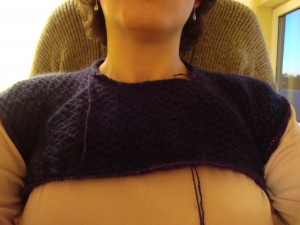
The armholes are joined, and I'm working my way down the body. This was my only plane knitting, so it's a bit further along now than it was in this photo. I haven't touched it since we landed, but I'm looking forward to getting back to it soon. It's so nice that it's back to only 400 stitches a round! (It was at almost 700 before the split, and those rounds were taking a really long time...)
In the week before we left, I re-knit the red scarf with a garter edge, and I turned the pattern sideways. I had hoped that this would help it to lay flat, as all of the curling had been at the long edges in the first version. Unfortunately, the sideways scarf did the same thing:
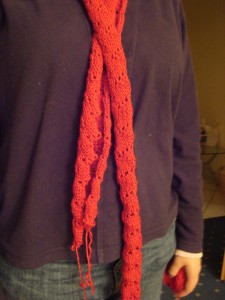
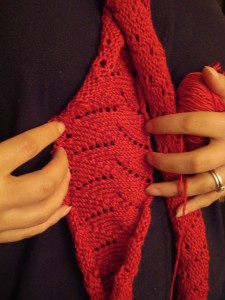
I also tried using a bigger needle, as Ellen suggested in the comments. The first scarf was knit on a 5; I moved up as far as a 9 and was still getting curling. In this case, I don't think it was the stitch pattern; it was the weight of the yarn pulling it into its cinnamon-stick shape.
I pulled the whole thing out and gave away the yarn instead of packing it. It will make a beautiful bag or something, knit up in a design that doesn't want a lot of stretch and that can bear a little weight. It just wasn't the right yarn for my purposes.
I had a little bit of SouthWest Trading Company bamboo in red waiting for me in my US stash, so I put the scarf aside until we came back here. Unfortunately, I didn't have as much as I remembered, and the yarn is old enough that it doesn't quite match the current colorway. Given the microfiber experience, I was also a little worried that the weight of a 100% bamboo yarn would cause the same problems with curl. Instead, I found some beautiful Frog Tree fingering weight alpaca (color 23) at my new LYS. This yarn is light and airy, much warmer than the microfiber, and has a beautiful halo. I wasn't sure how I'd like the pattern in a fuzzy yarn, since the clear stitch definition was my favorite thing about the microfiber version. And then I started knitting.
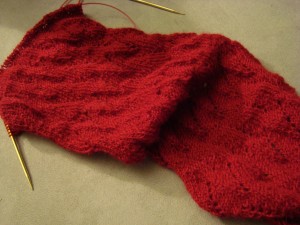
I cast on Thursday night, after realizing that I hadn't knit in almost a week. I haven't had much time for it since then, but it's flying off the needles, especially considering that Ifrogged back a good 12 inches when I discovered that I'd made errors setting up the stitch pattern.
I can't believe how much better it is. It doesn't have the same crisp stitch definition, but the alpaca yarn has a beautiful softness, and I love the way it catches the light. I tried for about an hour to get a good photo earlier, but I couldn't really get the new camera to capture it. I forsee some trial and error photoshoots in my future, as I learn the buttons and settings for this new camera.
We also visited another of Madison's yarn shops, looking for yarn for a second scarf. We didn't find the perfect color, but I love the one that we did find:
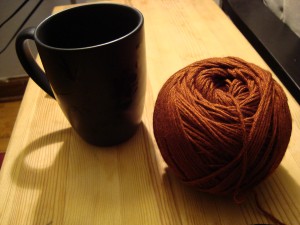
That's a silk-merino blend by Cascade called Venezia (color 160 - Ginger). I don't think I've ever seen Venezia before, but it's a beautiful yarn. The shine and the feel are perfect, even though there wasn't much available in the exact burnt-orange color that I was hoping for. I'm a little worried that I won't have enough yarn (it's only 160 yards), but I have a tendency to over-buy for projects, so I'm hoping that I'm overestimating what I'll need. There was plenty in the store, so I can go back for more if necessary.
My only complaint with the yarn is that there were three or four damaged areas in the skein that I didn't find until winding it into a ball. Cascade is usually better quality than that, so I'm hoping that it's just a fluke, because I think I'm very likely to knit with this again.
I'm not really sure yet what stitch pattern to use for this scarf. It should be a little bit more muted to match this other friends' personality, fairly open (to help with yardage, mostly), and something that really shows off the shine and drape of the yarn. Nothing has popped out of the Walker books yet, but we have another date this evening.
The waving lace pattern is also coming along well. I have one more chart section that needs to be test knit (for the last time, I hope!), a few stitch counts to calculate/verify, and then it's all layout, proofing, and editing.
And, last but not least, the geometric lace project is also coming along well. I couldn't get a good picture of the swatch tonight, so I'll have to show it to you later. One transition is completely mapped out, and it's waiting until I have some quiet time to focus on the other.
So there's the knitting status. I was thinking of writing a "State of the Stash" post, but that will have to wait for another day, when I'm up to a project of that magnitude. For now, I'm just glad to be able to find time to knit.
Posted by
EGunn
at
6:15 PM
|
![]()
Monday, November 30, 2009
Monday, November 23, 2009
Transitions
Flight date is fast approaching, and this has been a week of lasts. Last knitting meeting, last dinner with friends, last time grocery shopping in Germany, last this and last that. Closing up one life, preparing to move on to the next.
That might be part of the reason that I'm enjoying working out transitions in lace, finding one design that flows seamlessly and beautifully into the next.
In the waving lace shawl, I created the knitting and then began to chart and plan the pattern. I reknit the piece to make sure that the new plans would work. I have charted and swatched and charted again, tweaking and reinventing each time. It's almost done, but there is still some swatching left to do. When I began, I didn't know what I would need for the pattern. Working through the process has helped me to see what I will need at each stage, and how to set up a project so that it leads into a pattern with a little less reworking along the way. It's slow going, but I have learned a lot.
The transitions are the most important part, and they're the part that I knit most intuitively. I don't usually plan them; I knit until I get there, and then see what makes sense with the stitches as they sit on my needles. Sometimes I take notes, but they're not usually very thorough; more like a secret, cryptic code for myself than a set of clear instructions for someone else to follow.
This time, I am working on making those instructions more explicit the first time, in the swatching stage. This time, the first knit piece will be the test piece. This means that there's a lot more up-front planning involved.
I started out with the wave pattern that I showed you last time:
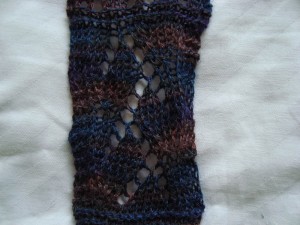
This pattern comes from the Walker books as an allover pattern, whose repeat begins at the center "stem" of the vine. But I want a single vine running down a knit panel.
I switched to a thicker yarn for this swatching, since I wanted better stitch definition than the dark laceweight could provide. No sense going blind trying to count stitches and remember where I put the decreases. I couldn't find my normal swatching yarn, so I used the red scarf yarn. First, I recharted the lace with one repeat in the center. In the allover pattern, the yo's bordering one vine feed into the next motif, creating its leaves. I replaced those extra yarnovers with make-one stitches, so that I would have just one vine on a solid background.
The vine pattern works by having yarnovers separated from decreases across the entire fabric, which causes the lace to widen and narrow as it's knit. In an allover fabric, this doesn't make much difference, as the width of one repeat compensates for the narrowness of another. In a single-repeat panel, though, it makes for wavy edges.
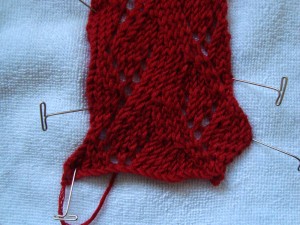
The first repeat (at the bottom) is knit in the pattern as given: the right-hand side bulges out, and the left-hand side dents in. After working that one repeat, I began eliminating make-one stitches and the corresponding decrease stitches so that the edges would stay straight.
This gave me the single vine that I wanted, but it also caused the whole pattern to shift over one stitch with every repeat, which wasn't exactly the effect I'd hoped for. I wanted a panel that went straight, not one that moved over one stitch every twelve rows. I fussed, I recharted, I fussed again. I counted stitches, I compared with the original pattern. It still translated over one stitch.
Eventually, I gave up on my charted version and decided to start again from scratch. I studied the way the increases and decreases worked together, and figured that I knew enough to just rewrite the whole thing. One thing I noticed was that there was a set of staggered decreases on each side of the vine, and that they were separated by four stitches running down the middle of the panel. I wanted a narrower piece anyway, and I couldn't see what they could possibly be good for, so I simply eliminated them.
As often happens, too much planning and analysis took the spontaneous, organic curves out of the design.
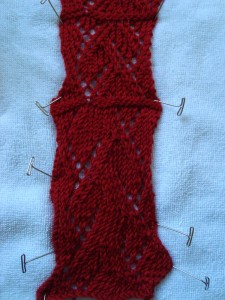
The part knit above the garter stitch separator is very similar to the first, and much narrower (just as I'd wanted), but it's missing the undulating curves that made this pattern interesting to begin with. The curves are a product of those four seemingly useless stitches that do nothing except run up the center of the piece, leaning left and right as the fabric around them increases and decreases. They're also a product of decreases worked on a different spacing than the increases. This didn't make sense to me, so I'd put the increases and decreases parallel to one another, and I'd lost the flow. Maybe I didn't understand this stitch pattern as well as I thought I did.
I went back to the beginning, and started over. I began with the original pattern, changed to solid increases, eliminated the wavy edges, following the same set of steps as before. This time, I paid more attention to the waves, and figured out that I'd added an extra yarnover while trying to force the pattern to follow lines too rigidly.
Now that the vines were cooperating, it was time to start working on the blocks. I'd found my swatching yarn and so I turned back to wool, which is a lot easier to work with. Again, I charted. Again, I got it wrong the first time (but only partially).I went back to the swatch and felt my way through it, ending up with this:
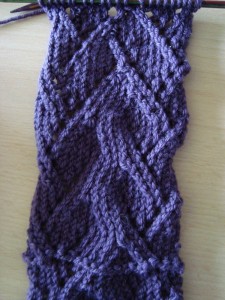
At the bottom, curvy vines. At the top, angular blocks. (Sorry for the horrible lighting...it's definitely November around here, and it's hard to get a good picture, even at noontime...)
And so it goes. Chart, swatch, chart. Analyze, overshoot, correct, try again. Correct the corrections, create the final chart.
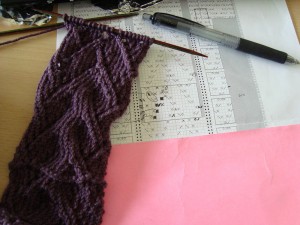
Posted by
EGunn
at
11:12 AM
|
![]()
Thursday, November 19, 2009
Sketch of a project
In between pattern writing and knitting, I've been poking around in the stitch dictionaries, looking for my next big lace project. I usually start brainstorming around one central pattern, and then try to find others that work with it, gradually feeling my way outward from that one central point. I mentioned before that I'm drawn to geometric patterns right now, I've had my eye on this one for a while:
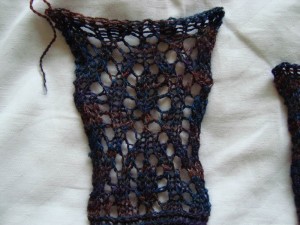
It's called pendants lace, and I love it. With more repeats, the two motifs interlock like little puzzle pieces. (It's very obvious in the Walker photo, not so obvious in my swatch. I wanted to use the Walker pictures in this post, but I'm not sure if that's Fair Use as far as copyright is concerned. Trust me, the two motifs interlock like little puzzle pieces....) My second trip to the stitch dictionaries focused around this one stitch pattern. What could I find that would match?
It's a complicated motif, and a pretty unusual one. There weren't many partners stepping up. But then I found myself coming back to this again and again:
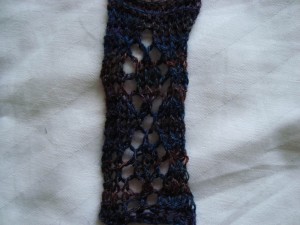
The motif looks a lot like the pendants in the pendant lace.
Then I looked for things that matched the slanted yo lines in the pendant lace.
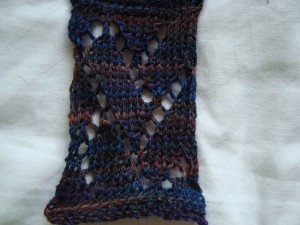
And for something to soften it.
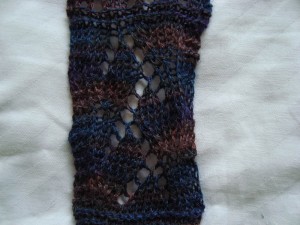
I added a wavy edging to go with the vines.
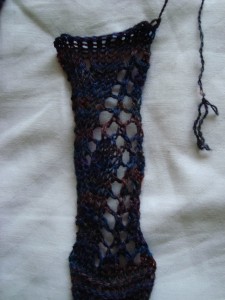
All of a sudden, I had my transition from rigid, geometric pattern to soft, undulating vines.
So, I swatched. I'm planning to use the Mountain Colors Winter Lace that Branden brought back from the U.S. in September. It's a 50/50 Merino/Silk mix, and it's beautiful. It's a real laceweight, so it's light enough to knit into a fairly solid fabric, and it's a generous skein that should last through a fairly dense lace project. These photos are a little bit dark, but they give you a pretty good idea of the colors.
And now, all that remains is figuring out how to put them together...
Posted by
EGunn
at
12:12 PM
|
![]()
